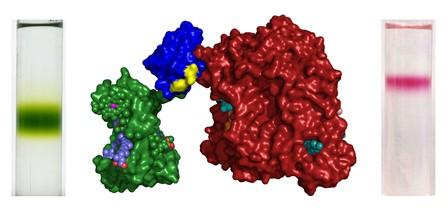Mar 25 2020
At the University of Bristol, a group of researchers has designed a new photosynthetic protein system that facilitates a more sustainable and improved approach to solar-powered technological devices.
 Proteins from a green plant and a purple bacterium are locked together by a genetically encoded interface domain (blue/yellow). Image Credit: University of Bristol.
Proteins from a green plant and a purple bacterium are locked together by a genetically encoded interface domain (blue/yellow). Image Credit: University of Bristol.
The initiative of the researchers forms part of a wider effort in the field of synthetic biology to make use of proteins as an alternative to man-made materials that are usually costly, scarce, and can be dangerous to the surrounding when the device turns obsolete.
The main goal of the research, which was recently published in the Nature Communications journal, was to develop “chimera” photosynthetic complexes that exhibit poly-chromatic solar energy harvesting properties.
As a first, the researchers could develop a single protein system that makes use of both bacteriochlorophyll and chlorophyll. Thus, they have illustrated that the two pigment systems can function together to realize solar energy conversion.
In the past, two main types of protein have been used for solar energy conversion in technological devices. The first are from ‘oxygenic’ photosynthetic organisms—plants, algae and cyanobacteria—that contain chlorophyll as their main photosynthetic pigment and produce oxygen as a waste product of the process.
Dr Mike Jones, Study Lead Author and Reader in Biochemistry, University of Bristol
Jones continued, “The second are from ‘anoxygenic’ organisms, bacteria that contain bacteriochlorophyll as their primary photosynthetic pigment.”
“We have assembled these two proteins, from very different parts of the photosynthetic world, into a single biological photosystem that enables expanded solar energy harvesting. We have also demonstrated that this system can be interfaced with man-made electrodes to achieve expanded solar-to-electric conversion,” added Jones.
The researchers from the BrisSynBio Institute of the University of Bristol collaborated with photoelectrochemistry colleagues at the Free University Amsterdam and purified a “reaction centre” protein derived from a light-tapping protein from a green plant (originally made recombinantly in Escherichia coli) and a purple-colored photosynthetic bacterium and closed them forever jointly.
This was performed by using a linking domain derived from a second bacterium. The outcome is the first single complex with a clearly defined protein and pigment composition that exhibits extended solar energy conversion.
The study, which was supported by EPSRC and BBSRC, was mostly the work of Dr Juntai Liu, a PhD student at the University of Bristol’s Centre for Doctoral Training in Synthetic Biology. This advancement is an example of a synthetic biology method, which treats proteins as components that can be combined in innovative and interesting ways with the help of a predictable and common interface.
This work shows that it is possible to diversify the protein systems which can be built into devices beyond those which nature supplies, using a simple approach achieved purely through genetic encoding.
Dr Mike Jones, Study Lead Author and Reader in Biochemistry, University of Bristol
According to Dr Jones, the further step is to extend the range of photosynthetic pigments, making use of proteins from cyanobacteria including bilin pigments that absorb orange and yellow light, as well as to find linking enzymes to these innovative photosystems to harness sunlight to power catalysis.